冀教版英语17课教案
- 格式:doc
- 大小:29.50 KB
- 文档页数:5
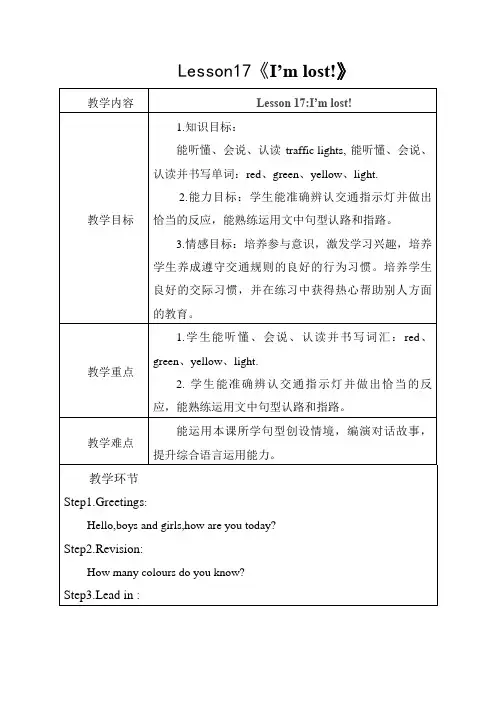
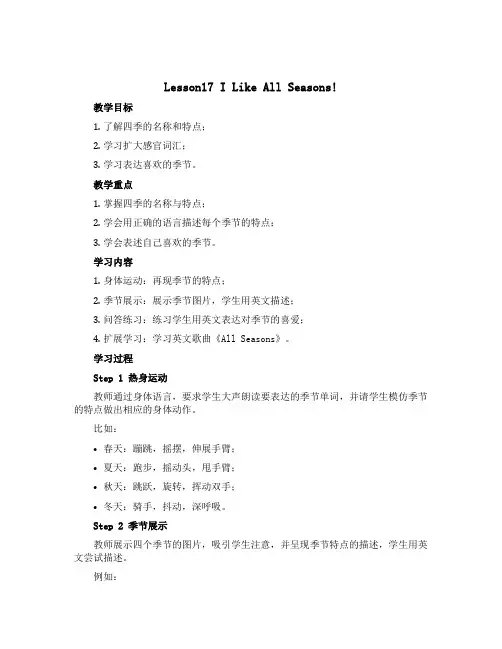
Lesson17 I Like All Seasons!教学目标1.了解四季的名称和特点;2.学习扩大感官词汇;3.学习表达喜欢的季节。
教学重点1.掌握四季的名称与特点;2.学会用正确的语言描述每个季节的特点;3.学会表述自己喜欢的季节。
学习内容1.身体运动:再现季节的特点;2.季节展示:展示季节图片,学生用英文描述;3.问答练习:练习学生用英文表达对季节的喜爱;4.扩展学习:学习英文歌曲《All Seasons》。
学习过程Step 1 热身运动教师通过身体语言,要求学生大声朗读要表达的季节单词,并请学生模仿季节的特点做出相应的身体动作。
比如:•春天:蹦跳,摇摆,伸展手臂;•夏天:跑步,摇动头,甩手臂;•秋天:跳跃,旋转,挥动双手;•冬天:骑手,抖动,深呼吸。
Step 2 季节展示教师展示四个季节的图片,吸引学生注意,并呈现季节特点的描述,学生用英文尝试描述。
例如:•春天(Spring):温暖,花开,新生;•夏天(Summer):晴天,炎热,海滩;•秋天(Autumn):色彩缤纷,丰收,落叶;•冬天(Winter):寒冷,雪花,火炉。
Step 3 问答练习教师问:“What’s your favorite season?”(你最喜欢哪个季节?)学生大声回答,并陈述理由。
如:•“My favorite season is spring. Because the flowers are blooming and the weather is warm.”•“My favorite season is summer because I like to swim in the pool and go to the beach.”•“My fa vorite season is autumn because I like the colors of the leaves and the cool weather.”•“My favorite season is winter. Because I like to play in the snow and drink hot chocolate.”Step4 扩展学习展示英文歌曲《All Seasons》,学生跟唱歌曲,尝试理解歌词。
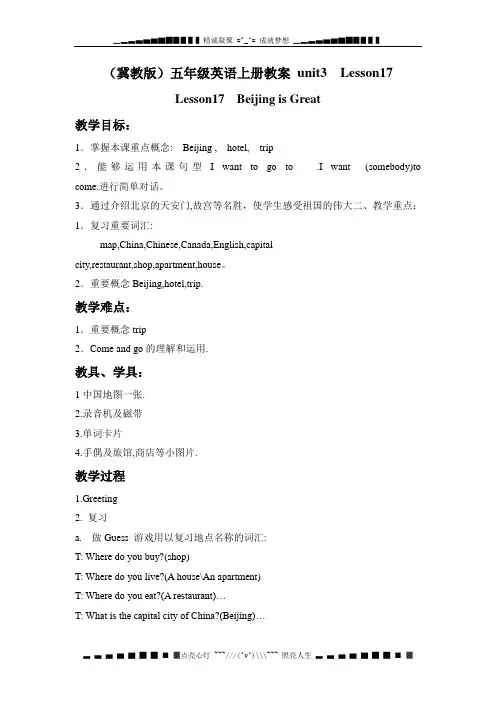
(冀教版)五年级英语上册教案unit3 Lesson17Lesson17 Beijing is Great教学目标:1.掌握本课重点概念: Beijing , hotel, trip2.能够运用本课句型I want to go to ___.I want___(somebody)to come.进行简单对话。
3.通过介绍北京的天安门,故宫等名胜,使学生感受祖国的伟大二、教学重点:1.复习重要词汇:map,China,Chinese,Canada,English,capitalcity,restaurant,shop,apartment,house。
2.重要概念Beijing,hotel,trip.教学难点:1.重要概念trip2.Come and go的理解和运用.教具、学具:1中国地图一张.2.录音机及磁带3.单词卡片4.手偶及旅馆,商店等小图片.教学过程1.Greeting2. 复习a. 做Guess 游戏用以复习地点名称的词汇:T: Where do you buy?(shop)T: Where do you live?(A house\An apartment)T: Where do you eat?(A restaurant)…T: What is the capital city of China?(Beijing)…b.做Spell It 游戏用以复习学生已经掌握的关于地点名称的词汇.(利用单词卡片瞬时记忆)3.教授重要概念:出示中国地图,和学生一起找到北京,示范Beijing 一词.之后,在地图上贴上旅馆小图片.演示trip和hotel.手偶: I am going on a trip.教师: Where are you going ?手偶: I am going to ___.(目的地名称)教师: Do you live in ___?(目的地名称)手偶: No!I live in ___(所在城市名称).I live in a house\an apartment.教师: Do you have a house in ___(目的地)?手偶: No!I go to a hotel!Here I go !I am going on a trip to___!4. 与学生一起讨论有关北京的图片.他们最喜欢什么?谁曾到过北京?(the Palace Museum\Tian an men Square\hltel)5. play a game : Come here Go there6. 请同学们打开书,边听录音边找出表示地点的词汇.7.Read after the tape.8.练习:a. 制作题为A trip to Beijing 的张贴画.学生拿出课前准备好的图片,胶水,纸.4人1组.教师和学生一起开动脑筋,边制作,边鼓励学生尽可能多地运用英语.b. 造句练习要求学生以去哪及和谁一起去为内容造句.学生可以用任何地方为旅行的目的地.还要说出与他一起旅行的朋友的名字.I want to go to ___. I want ___and___to come ,too.c. 检查理解和应用请学生向全班陈述他们的张贴画,尽量使用完整的句子.9. 作业: a. 完成<活动手册>剩余部分.b. Talk about a trip.Make a travel plan.板书设计:五年级第三单元第17课教案I、教学目标一、知识与技能目标:1、正确的认读单词trip hotel famous2、掌握短语go on a trip/go on trips want to + 动词词组3、能用英语讨论北京的一定概况。

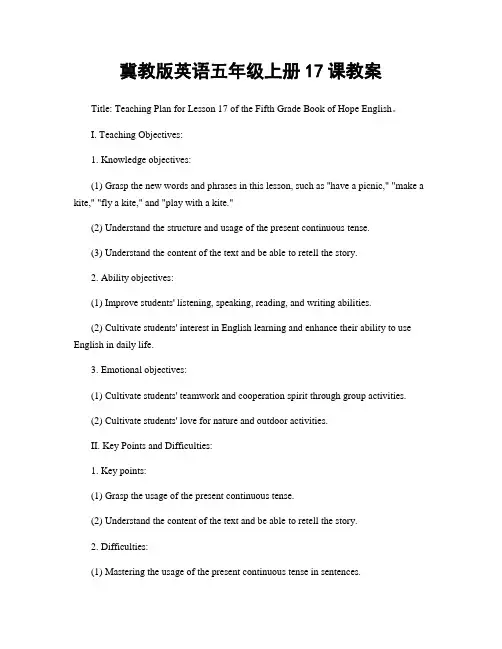
冀教版英语五年级上册17课教案Title: Teaching Plan for Lesson 17 of the Fifth Grade Book of Hope English。
I. Teaching Objectives:1. Knowledge objectives:(1) Grasp the new words and phrases in this lesson, such as "have a picnic," "make a kite," "fly a kite," and "play with a kite."(2) Understand the structure and usage of the present continuous tense.(3) Understand the content of the text and be able to retell the story.2. Ability objectives:(1) Improve students' listening, speaking, reading, and writing abilities.(2) Cultivate students' interest in English learning and enhance their ability to use English in daily life.3. Emotional objectives:(1) Cultivate students' teamwork and cooperation spirit through group activities.(2) Cultivate students' love for nature and outdoor activities.II. Key Points and Difficulties:1. Key points:(1) Grasp the usage of the present continuous tense.(2) Understand the content of the text and be able to retell the story.2. Difficulties:(1) Mastering the usage of the present continuous tense in sentences.(2) Understanding the content of the text and retelling the story in English.III. Teaching Procedures:1. Warm-up (5 minutes):(1) Greet the students and review the previous lesson.(2) Show pictures of different outdoor activities and ask students to describe what they see using the present continuous tense.2. Presentation (15 minutes):(1) Introduce the new words and phrases in this lesson, such as "have a picnic," "make a kite," "fly a kite," and "play with a kite."(2) Explain the usage of the present continuous tense and provide examples to help students understand.3. Practice (20 minutes):(1) Play a recording of the dialogue in the text and ask students to listen and repeat.(2) Divide the class into groups and ask each group to make a dialogue using the new words and the present continuous tense.(3) Ask students to read the text and answer questions about the story.4. Consolidation (15 minutes):(1) Play a game where students act out different outdoor activities while using the present continuous tense to describe what they are doing.(2) Ask students to write a short paragraph about their favorite outdoor activity using the present continuous tense.5. Homework (5 minutes):(1) Assign homework, such as writing a diary entry about a picnic or making a kite.(2) Review the key points of the lesson and preview the next lesson.IV. Blackboard Design:New words and phrases: have a picnic, make a kite, fly a kite, play with a kite。
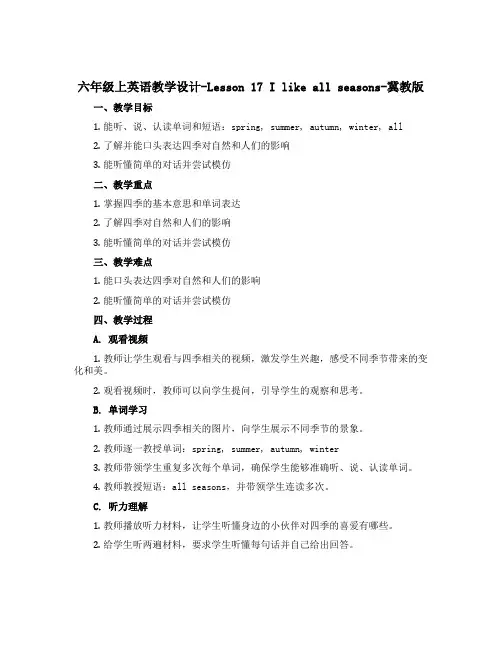
六年级上英语教学设计-Lesson 17 I like all seasons-冀教版一、教学目标1.能听、说、认读单词和短语:spring, summer, autumn, winter, all2.了解并能口头表达四季对自然和人们的影响3.能听懂简单的对话并尝试模仿二、教学重点1.掌握四季的基本意思和单词表达2.了解四季对自然和人们的影响3.能听懂简单的对话并尝试模仿三、教学难点1.能口头表达四季对自然和人们的影响2.能听懂简单的对话并尝试模仿四、教学过程A. 观看视频1.教师让学生观看与四季相关的视频,激发学生兴趣,感受不同季节带来的变化和美。
2.观看视频时,教师可以向学生提问,引导学生的观察和思考。
B. 单词学习1.教师通过展示四季相关的图片,向学生展示不同季节的景象。
2.教师逐一教授单词:spring, summer, autumn, winter3.教师带领学生重复多次每个单词,确保学生能够准确听、说、认读单词。
4.教师教授短语:all seasons,并带领学生连读多次。
C. 听力理解1.教师播放听力材料,让学生听懂身边的小伙伴对四季的喜爱有哪些。
2.给学生听两遍材料,要求学生听懂每句话并自己给出回答。
D. 对话模仿1.教师给学生展示对话,鼓励学生模仿。
2.教师让学生分组,自己编写对话,展示出各个季节的美好。
E. 听写练习1.教师让学生举起拇指,随着教师的念叨,学生听到相关的单词就放下拇指。
2.通过这种方式,让学生更加熟悉四季单词的拼写和发音。
五、教学评价1.教师可以在晚自习的时候,做出学生单独对单词发音的评测。
2.听力模仿和对话练习可以在课堂上直接进行评分。
3.教师可以在测试中加入听力理解和口头表达的考试内容。
六、教学反思通过以上教学设计,学生可以灵活地应对身边变化的环境和思考自然的美。
如果考虑区别学生个性的差异,针对特定学生群体,增加相关的练习和学习方式,将让教学的效果进一步提升。
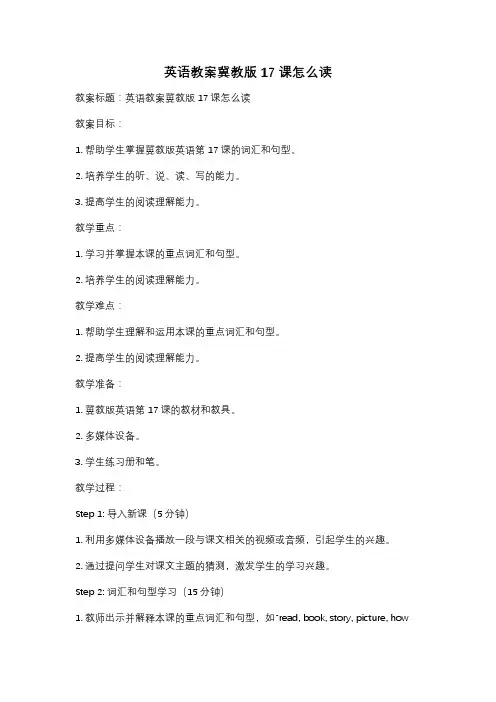
英语教案冀教版17课怎么读教案标题:英语教案冀教版17课怎么读教案目标:1. 帮助学生掌握冀教版英语第17课的词汇和句型。
2. 培养学生的听、说、读、写的能力。
3. 提高学生的阅读理解能力。
教学重点:1. 学习并掌握本课的重点词汇和句型。
2. 培养学生的阅读理解能力。
教学难点:1. 帮助学生理解和运用本课的重点词汇和句型。
2. 提高学生的阅读理解能力。
教学准备:1. 冀教版英语第17课的教材和教具。
2. 多媒体设备。
3. 学生练习册和笔。
教学过程:Step 1: 导入新课(5分钟)1. 利用多媒体设备播放一段与课文相关的视频或音频,引起学生的兴趣。
2. 通过提问学生对课文主题的猜测,激发学生的学习兴趣。
Step 2: 词汇和句型学习(15分钟)1. 教师出示并解释本课的重点词汇和句型,如"read, book, story, picture, how2. 教师通过多种方式,如图片、示范等,帮助学生理解和掌握这些词汇和句型。
Step 3: 阅读理解训练(20分钟)1. 教师根据课文内容,设计一些与课文相关的问题,让学生进行阅读理解训练。
2. 学生可以个别或小组合作完成问题,教师可以提供必要的提示和指导。
Step 4: 听力训练(10分钟)1. 教师播放与课文内容相关的录音,要求学生仔细听,理解录音中的内容。
2. 学生根据听到的内容回答问题,教师根据学生的回答情况,给予必要的反馈和指导。
Step 5: 读写训练(15分钟)1. 学生个别或小组合作,朗读课文并模仿录音中的语音语调。
2. 学生根据课文内容,完成相关的写作练习,如写一篇关于自己喜欢的书的短文。
Step 6: 课堂总结(5分钟)1. 教师与学生一起回顾本节课所学的重点词汇和句型。
2. 教师鼓励学生积极参与课堂活动,并给予肯定和鼓励。
Step 7: 作业布置(5分钟)1. 教师布置相关的课后作业,如完成练习册上的习题,或写一篇关于自己喜欢的书的短文。
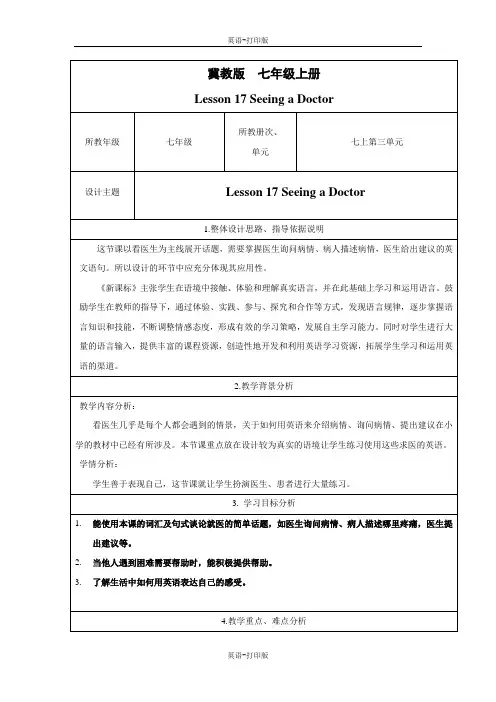
教学重点:1. 能自如地用How do you feel? What's wrong? What's the matter? 询问病情,并给予回答。
2. 学会had better do 的用法。
教学难点:医患之间的对话。
5.教学过程设计步骤1:Warm upHave a free talk with the students, then teach them the new words and expressions.设计意图:通过聊天使学生以愉快、放松的心情投入本节课的英语学习,吸引学生的注意力,激发他们的好奇心,同时巧妙地引出本课生词。
步骤2:出示学习目标。
设计意图:做到有的放矢,清楚本节课要完成的任务和途经。
步骤3:学习生词。
通过语篇,引出生词及重点短语。
stomachache n. 肚子痛;胃痛The man has a stomachache.=The man’s stomach hurts.=The man has a pain in his stomach.What should you do when you have a stomachache?better adj. &adv. (good/well的比较级)更好的(地)Good, better, best,Never let it rest,Till good is better,And better, best.matter n. 问题1. Don't you think this is now a matter for the police?...难道你不觉得这件事现在该交由警方处理吗?2. Age doesn’t matter. 年龄不是问题。
3. What’s the matter with …?headache n. 头痛She has a bad headache when she thinks of her homework. She had a headache after eating the food.medicine n. 药My mother had a bad cold yesterday. She had some medicine and went to bed. She became better and better after that.stay v. 停留;留下;待一段时间rest v. &n. 休息The boy coughed a lot last night. Now he stays home and has a good rest. He should drink plenty of water.设计意图:通过图片引出stomachache,通过介绍孩子肚子疼,该怎么办,引出had better,通过一首小诗,了解better的含义,然后介绍了头疼等的词汇及看医生常用到的句式。

Lesson17 The Travel Plan 教案一、教学目标1.知识目标:能听、说、读、写单词Sunday, Monday, T uesday, W ednesday, Thursday, Friday, Saturday.能辨别出igh, y 和i 在单词中的发音。
2.能力目标:能用简单地英语描述自己的旅行计划。
3.情感目标:让学生明白如何做计划,安排好自己的时间。
二、教学重难点重点:能够听说认读并运用重点词汇。
难点: 能用简单地英语描述自己的旅行计划。
能辨别出igh, y 和i 在单词中的发音。
四、教学过程1.复习旧知,引入新课:We know Li Ming wants to travel to Beijing.我们已经知道李明已经打算去北京旅行。
And he is a good boy.他是一个好孩子。
He knows he needs a plan.Now let us learn about travel plans.他知道他需要一个计划。
现在我们来一起学习旅行计划。
2.新授:(1)Making a travel plan.回忆英语中日期的读法。
学习本节重点单词星期日到星期一(之前也已学过),教师领读。
课件出示We are going to travel by train. We will go to Beijing on February 3.学生应该能说出李明他们即将坐火车旅行,他们要在2月3日去北京。
学生读,然后教师介绍be going to的相关知识。
让学生看李明的旅行计划。
Look at Li Ming’s travel plan.讲旅行计划的所有部分,使学生理解计划是怎样进行的。
在星期和日期下面,李明写下了他会做什么。
例如:周日,2月2日,他将为旅行做准备。
We will get ready for the trip on February2.按上述方法讲完整个旅行计划。
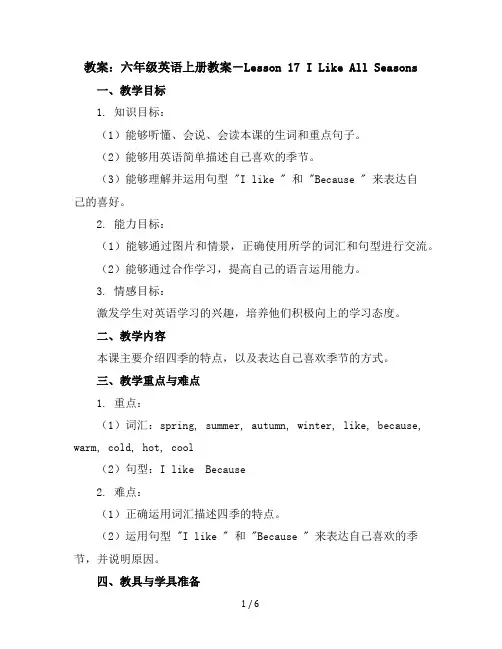
教案:六年级英语上册教案-Lesson 17 I Like All Seasons一、教学目标1. 知识目标:(1)能够听懂、会说、会读本课的生词和重点句子。
(2)能够用英语简单描述自己喜欢的季节。
(3)能够理解并运用句型 "I like " 和 "Because " 来表达自己的喜好。
2. 能力目标:(1)能够通过图片和情景,正确使用所学的词汇和句型进行交流。
(2)能够通过合作学习,提高自己的语言运用能力。
3. 情感目标:激发学生对英语学习的兴趣,培养他们积极向上的学习态度。
二、教学内容本课主要介绍四季的特点,以及表达自己喜欢季节的方式。
三、教学重点与难点1. 重点:(1)词汇:spring, summer, autumn, winter, like, because, warm, cold, hot, cool(2)句型:I like Because2. 难点:(1)正确运用词汇描述四季的特点。
(2)运用句型 "I like " 和 "Because " 来表达自己喜欢的季节,并说明原因。
四、教具与学具准备1. 教具:PPT、图片、四季卡片、录音机、磁带2. 学具:课本、练习本、铅笔、橡皮五、教学过程1. 热身(5分钟)(1)教师与学生用英语进行简单的问候,询问学生上周的学习情况。
(2)学生集体做英语歌曲或韵律操,活跃课堂气氛。
2. 引入(10分钟)(1)教师向学生展示四季的图片,引导学生用英语描述四季的特点。
(2)教师引导学生谈论自己喜欢的季节,并说明原因。
3. 讲解(15分钟)(1)教师讲解本课的生词和重点句子,让学生跟读并模仿。
(2)教师通过举例和情景模拟,引导学生运用句型 "I like "和 "Because " 来表达自己喜欢的季节。
4. 练习(10分钟)(1)学生分小组进行角色扮演,运用所学词汇和句型进行对话。
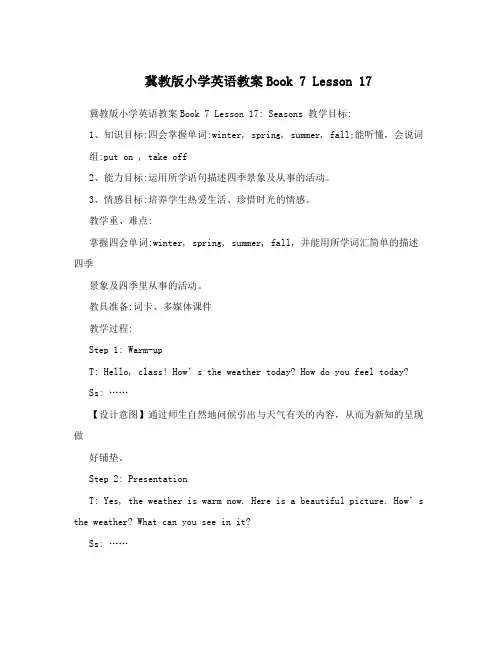
冀教版小学英语教案Book 7 Lesson 17 冀教版小学英语教案Book 7 Lesson 17: Seasons 教学目标:1、知识目标:四会掌握单词:winter, spring, summer, fall;能听懂,会说词组:put on , take off2、能力目标:运用所学语句描述四季景象及从事的活动。
3、情感目标:培养学生热爱生活、珍惜时光的情感。
教学重、难点:掌握四会单词:winter, spring, summer, fall,并能用所学词汇简单的描述四季景象及四季里从事的活动。
教具准备:词卡、多媒体课件教学过程:Step 1: Warm-upT: Hello, class! How’s the weather today? How do you feel today?Ss: ……【设计意图】通过师生自然地问候引出与天气有关的内容,从而为新知的呈现做好铺垫。
Step 2: PresentationT: Yes, the weather is warm now. Here is a beautiful picture. How’s the weather? What can you see in it?Ss: ……T: This is a picture of spring. (learn “spring”) Spring is a season. ( learn “season”)In spring, the weather is warm and rainy. There are many flowers and trees. The flowersbloom and the trees are green. I can go on a trip in spring. What can you do in spring?Ss: ……T: What season is coming after spring? Ss: ……T: Yes, this is summer. ( learn “summer”) Summer is a season, too. Can you talk aboutsummer? How’s the weather in summer? What can you see? What can you wear?What can you do?Ss: ……T: Who can talk about summer?Ss: ……T: Do you like riddles?Now listen. The weather is cool and windy in this season. The wind blows the yellow leaves off the trees and there are many fruits. What season is it? Can you guess?Ss: ……T: It is fall. ( learn “fall”) Fall is a season. Can you say something about fall? Ss: ……T: After fall, winter is coming. ( learn “winter”) Winter is a season. Winter is different. Can you say?Ss: ……T: Good work. Look, spring, summer, fall and winter are seasons. How many seasons in a year?Ss: Four.T: Right! There are four seasons in a year. Here’s a chant for seasons. First follow mequietly. Then let’s chant loudly.……T: Look, I wear a T-shirt and a pair of jeans today. Can I wear them in winter? Ss: ……T: Yes. In winter, the weather is very cold. So I put on my winter coat. I put on my scarf. I put on my gloves. ( learn “put on”) But in spring, the weather is warm. So Itake off my scarf. I take off my gloves. I take off my winter coat. ( learn “take off”)What do you put on or take off in different seasons? Let’s ask and answer in pairs.Ss: ……【设计意图】通过图片直观地展现四季,给学生们提供可谈论的话题,可以围绕不同季节的天气、景象、衣着、活动并结合自己的生活实际交流,让英语的学习更生活化、情景化。
Lesson17.《I’m Lost!》(说课稿)一、教材分析1. 教材情况《I’m Lost!》是2022-2023学年英语四年级上册的第十七课,教程为冀教版(三起)。
2. 学生情况本节课为四年级上册的第十七课,学生年龄大多为10岁左右,英语学习时间大约为一年左右,掌握程度不一。
3. 教学目标1.能够听懂和理解短文,从中捕捉关键信息。
2.能够掌握一些关于获取帮助的常用英语表达。
3.能够根据情境运用所学知识进行实际交流。
4. 教学重点1.掌握获取帮助的基本表达。
2.学会运用所学知识进行实际交流。
5. 教学难点学生表达情感需要借助相关单词和表达,需要有一定的语言基础。
二、教学内容1. 教学过程(1)热身阶段请学生们表演一下“丢失物品,需要寻求帮助”的情形,以此激发学生的学习兴趣。
(2)听说阶段1.朗读并理解短文。
老师可以给学生播放《I’m Lost!》的录音,让学生听一遍短文,然后再让学生朗读一遍短文,明确短文的意思。
2.词汇解析(1)-help, lost, find。
将这批单词给学生讲解一下,让学生认识这些单词,并能够理解短文中的意思。
3.词汇解析(2)-Can you help me?。
这是获取帮助时需要用到的常用语,老师可以给学生教授一些常用句式,以帮助学生理解短文。
4.课堂讨论。
学生可以在老师的帮助下,模拟丢失物品的情况,利用所学知识进行交流。
(3)拓展阶段老师可以给学生安排一定的拓展练习作业,以巩固所学知识,并帮助学生发现表达时可能存在的一些问题。
2. 教材评价本节课通过生动的短文和清晰的指导,给学生提供了获取帮助的常用表达,学生能够有机会在模拟情况下进行实际操作和学习。
这些知识将帮助学生更好的融入英语环境,并提高英语交流能力。
三、教学反思1.教学思路:本节课的教学主要是通过老师的示范和指导,让学生学会获取帮助的常用表达,学L生可以通过模拟情况下进行实际操作和学习。
通过拓展作业巩固所学知识。
冀教版五年级《Lesson 17: Beijing Is Great!》教学设计【教材分析】本课是冀教版五年级Unit 3 :“A Trip to Beijing” 系列学习主题之一。
既是Unit 2 :“China” 内容的延伸,又是Unit 3 :A Trip to B eijing故事的开端,具有承上启下的作用.本课主要是讲李明计划去北京旅游,他将邀请朋友同行,并且带领我们重新复习了北京的一些著名景地。
本课内容丰富,围绕李明的旅行计划展开,为学生创设想要和朋友去北京旅行的情境,让学生在交流中运用。
【学习目标】1.能听、说、读、写单词:Beijing、trip、hotel2.能认读单词:great 、beautiful、 famous3.能听懂本课句型:Let’s go on a trip.I want to go to (somewhere).I want (somebody) to come ,too.并能进行简单对话。
4.能用英语简单描述北京并能运用相关北京图片进行交流,感受祖国的伟大。
【教学过程】第一部分:开始上课和复习1.问候T: Hello, everyone! How are you today? Look out the window. How’s th e weather today?(设计意图:轻松会话,互相问候,拉近与学生间的距离。
)2.复习T: First, let’s have a revision.a.认读单词,用以复习学生已经掌握的词汇:China 、 Canada 、Australia、 Chinese 、English、French、map 、capital city、restaurant、 shop、apartment 、 house 、 come 、 go .(1)指名读——师指着学生说You please!(2)集体读——师说Now , letˊs read them twice together .T: Can you answer these questions? —— Yes or No ? Who wants to try?b. 回答问题,用以复习地点名称的词汇:T: Where do you buy? (shop)T: Where do you live? (A house或 An apartment)T: Where do you eat? (A restaurant)T: What is the capital city of China? (Beijing)(设计意图:师生自由对话,使学生很快融入到英语课堂中,利用课件快速复习学过的知识,帮助学生回忆所学并为下面的学习做铺垫。
五年级上册英语教案- Lesson17 The Travel Plan 冀教版一、教材分析本节课是《冀教版》五年级上册英语第十七课《The Travel Plan》。
主要教授旅游计划的相关内容,包括旅游目的地、旅游日期、旅游交通方式、旅游费用等方面的知识。
二、学情分析本节课适用于五年级初学英语的学生。
学生拥有一定的英语基础,理解简单的英语对话并活学活用一些基础的英语单词和句型。
但是学生在听说方面还有一定的不足。
因此,本节课在听说方面作为主要教学内容,通过丰富多彩的教学活动,激发学生学习英语的兴趣和积极性。
三、教学目标1.知道问询旅游计划的基本问题:目的地、日期、交通方式等。
2.学会简单地表述自己的旅游计划并听懂其他人对旅游计划的描述。
3.提高学生听说能力,增强学生自信心和英语语感。
四、教学重难点1. 教学重点1.熟练掌握目的地、日期、交通方式等基本英语表达方式。
2.学会听懂和表述自己的旅游计划。
2. 教学难点提高学生听说能力,培养学生的语感和自信心。
五、教具准备1.电视或投影仪。
2.教学卡片。
六、教学过程1. 自我介绍教师向学生介绍自己,并询问学生近期的旅游计划。
2. 听力训练1.聆听录音,理解基本旅游计划问题。
2.小组讨论,收集旅游计划信息。
3. 口语练习1.学生表述自己的旅游计划。
2.学生相互询问旅游计划信息。
4. 经典对话学生在观看经典旅游对话后,自己模拟对话。
5. 作业布置要求学生将自己的旅游计划用英语写成一篇段落,并在课堂上口头介绍。
七、教学反思本节课从听说方面加强了教学效果,因为口语练习对于英语学习至关重要。
教材考虑到了学生的实际情况,针对性很强。
教师通过设计多种教学活动,让每一个学生都能有机会参与到课堂中来,起到了良好的教育效果。
教案:四年级上册英语教案Lesson 17 I’m Lost! | 冀教版一、教学目标:1. 知识目标:(1)学生能够听懂、会说、会读本课的生词和重点句子。
(2)学生能够通过情景交际,运用所学知识进行简单的日常交流。
2. 能力目标:(1)学生能够正确书写字母 "f" 和 "l"。
(2)学生能够在图片的帮助下,正确使用地图。
3. 情感目标:培养学生学会寻求帮助,培养合作意识。
二、教学内容:1. 生词:map, street, right, left, corner, post office, hospital, school 等。
2. 重点句子:Where is the post office?It’s on the right.Excuse me, where is the school?I’m lost. Can you help me?三、教学重点与难点:1. 重点:学生能够听懂、会说、会读本课的生词和重点句子,能够在实际情景中运用。
2. 难点:字母 "f" 和 "l" 的正确书写,以及如何在地图上找到目的地。
四、教具与学具准备:1. 教具:教材、多媒体课件、录音机、磁带。
2. 学具:练习本、铅笔、橡皮、地图。
五、教学过程:1. 热身(5分钟)(1)唱英文歌曲 "I'm a Little Teapot"。
(2)老师出示各种物品,学生用中文描述物品的位置。
2. 引入(10分钟)(1)老师出示地图,引导学生关注地图上的标记。
(2)学生尝试用英语描述地图上的物体。
3. 呈现(15分钟)(1)老师播放课文录音,让学生跟读。
(2)老师讲解生词和句子的意思,引导学生模仿发音。
4. 练习(15分钟)(1)学生分角色扮演,进行情景交际。
(2)老师提问,学生用英语回答。
5. 应用(10分钟)(1)学生分组,每组选择一个目的地,根据地图找到路线。
冀教版英语三年级上册: Lesson17 Are You Okay 说课稿一、教材分析本节课是冀教版英语三年级上册的第17课,名为 Are You Okay。
本课旨在让学生掌握关于身体部位的单词及它们的表达方式,能够用英语向他人表达自己或他人的健康状况。
本课通过简单的问候和回答方式,让学生在语言中了解乐于助人、互相关心的重要性。
二、教学目标•能正确听、说、认读 head, shoulders, knees, toes, eyes, ears, mouth, nose, stomach等单词;•能用简单的英语询问和表达疼痛的部位,例如 Are you okay? Is your head okay? My nose hurts, 等;•能理解道谢和帮助的表达方式,例如Thank you. You’re welcome.等。
三、教学重难点•教学重点:让学生掌握单词,能够用英语表达健康状况;•教学难点:运用英语表达身体部位。
四、课前准备•制作课件,加深学生对单词的印象;•准备一些图片,通过图片引入单词;•制作一份小练习,检验学生对课前内容的掌握情况。
五、教学步骤1. 首先向学生讲述今天的主题今天我们将要学习表示身体部位的单词,像头、肩膀、膝盖、脚趾、眼睛、耳朵、嘴巴、鼻子、胃等等。
我们将通过简单的问候和回答方式,学习用英语询问身体健康状况以及向他人表达道谢和帮助。
2. 引入单词通过图片向学生展示不同身体部位的图片,让学生模仿老师或录音机的读音,逐个学习这些单词:head, shoulders, knees, toes, eyes, ears, mouth, nose, stomach。
3. 练习用英语表达身体部位教师将身体部位单词逐个展示在课件上,通过图片引导学生回答问题。
例如:Where is your head? Where are your shoulders?4. 练习用英语询问健康状况老师示范用英语询问健康状况,例如:Are you okay? Is your head okay? My nose hurts. Are your toes okay? 然后让学生模仿老师的问话和回答,互相练习。
Lesson17.《I’m Lost!》(教案)一、教学目标:知识目标:1.学习和掌握用于问路的问句和指示方向的表达方式。
2.学习用简单的句子表达自己的想法和感受。
3.让学生理解和掌握课文中的重点词汇和短语。
能力目标:1.能够听懂、理解和描述生活中常见的场景,如:在路上迷路,问路等。
2.能够有效地表达自己的观点和想法。
3.能够配合老师进行对话练习,并自信地运用所学的语言进行交流。
二、教学重难点:教学重点:1.学习和掌握用于问路的问句和指示方向的表达方式。
2.学习用简单的句子表达自己的想法和感受。
教学难点:1.教学生如何理解和掌握课文中的重点词汇和短语。
2.教学生如何在实际生活中运用所学的语言进行交流。
三、教学过程:A. Warming-up1.Greetings and self-introduction2.Review some common phrases and expressions that they learned in previous lessons related to directions and locations.B. Presentation1.Show a picture of a city street on the board, and elicit from students some possible questions they might ask if they were lost.2.Review the cardinal directions (north, south, east, and west) and basic location words (left, right, straight ahead, etc.).3.Introduce and practice new vocabulary words related to directions and locations, using flashcards and miming.C. Reading and Listening1.Play the audio recording of the dialogue and have the students listen carefully.2.Have the students practice reading the text aloud, either as a class or in small groups.3.Ask comprehension questions to ensure the students have understood the dialogue.D. Practice1.Split students into pairs or groups and have them practice the dialogue with each other, alternating between being the lost person and the passerby.2.Encourage the students to use the new vocabulary words and expressions introduced earlier in the lesson.3.Monitor and provide feedback as the students practice.E. Extension1.Ask students to create their own dialogues in which they areeither lost or helping someone who is lost.2.Encourage them to use the new vocabulary they have learned and to be creative with the situations they imagine.3.Have students present their dialogues to the class, or record them and play them back for the whole class to hear.F. Summary and Homework1.Review the key vocabulary and phrases from the lesson.2.Assign homework, such as writing a short paragraph about a time they got lost or helping someone who was lost and using some of the new vocabulary words and expressions they have learned.四、教学评价:A. Formative Assessment:1.Observe students’ participation during group or pair activities.2.Listen to their speaking during various activities throughout the lesson.3.Provide feedback and make suggestions for improvement.B. Summative Assessment:1.Have the students complete a written quiz or test that assesses their understanding of the new vocabulary words and phrases introduced in the lesson.2.Listen to their oral performances during group or pair activities.3.Give students a grade based on their comprehension, speaking fluency, and accuracy.。
【教材】冀教版六年级英语上册
【教学内容】Lesson 17 Seasons
【知识目标】
1、掌握单词season winter spring summer fall put on take off
2、认读单词scarf mittens sandals blows off
3、句型掌握In____ ,I take off my ________,I put on my ______. 【技能目标】
通过本课学习,能熟练介绍自己喜欢的季节及其该季节的天气特征,人们的着装情况。
【情感态度价值观】
通过设置情境的联系活动,培养学生敢说、多用英语表达自己想法的习惯。
【教学方法】讲解法,情境设置法,图文结合,师生互动
【教具准备】电脑,电视,课件,单词卡片,四季图片
【教学重难点】
1、学生的口语训练。
2、掌握并背诵描述四季特征的句型。
【教学过程】
一、Let’s sing a song.
Can you sing “where is Jenny?”(课件1)
二、热身训练。
1、How are you?
2、How’s the weather today?
3、What do you wear?
三、引出本课。
A: Do you know how many seasons are there in a year? B: Four seasons.
Winter,spring,summer and fall are seasons.
四、新课。
1、出示图片介绍四季。
(课件4567)
2、操练句型熟悉四季单词。
A: Which season is it?
B: It’s _______ .
3、学生操练。
Ok, you can say them with your friend.
4、Let’s get into the seasons of a year.
Different feel for different seasons.
Different clothes for different seasons.
What’s mean?
理解句意
应用句型了解四季。
Which season is it? It’s _______ .
____ is coming.
___ is ____. 如:winter is cold.
<1> Which season is it ? It’s _____ .
winter is coming. winter is cold.
What are these? These are flowers.
There is ice. Snow is white.
A: What do you wear in winter?
B: In winter ,I put on my hat, scarf, mittens, jacket and winter boots.
<2> Which season is it ? It’s _____ .
spring is coming. Spring is warm and rainy . The flowers bloom.
A: What do you wear in spring/
B: In spring ,I take off my winter clothes, I put on my spring clothes.
I have my rain boots and umbrella. I like the rain ,but I don’t like to get wet.
<3> Which season is it ? It’s _____ .
Summer is coming. Summer is hot. What a hot ,sunny day!
A: What do you wear in summer ?
B: In summer , I take off my spring clothes, I put on my summer clothes.
I put on my shorts, T-shirt and sandals.
<4> Which season is it ? It’s _____ .
Fall is coming. Fall is cool. The wind blows the leaves off the tree.
A: What do you wear in fall?
B: In fall, I take off my summer clothes , I put on my fall clothes.
I put on my pants and a sweater.
5、回顾四季,回顾句型。
6、联系实际,操练句型。
<1>A: Which season is it , now?
B: It’s fall. Fall is cool. I take off my summer clothes, I put on my sweater and pants.
<2>A: What’s your favourite season?
B: My favourite season is ______ .
A: What do you wear?
B: In ____ , I put on my _________ .
7、分组交流以上句型。
You can say them with your friend .
8、小结本课知识。
Look at the blackboard .Today ,we are study seasons,We know
How many seasons are there in a year?
Four seasons. Winter, spring, summer and fall are seasons.
In____ , I take off my ____ , I put on my ______ .
…
9、听,读课文。
五、结束新课。
Sing a song.
六、结束课堂。
板书设计:
Lesson 17 Seasons
A: How many seasons are there in a year?
B: Four seasons.
spring
In ____ , I take off my ___ , I put on my ____ .
summer
fall
What a hot , sunny day!。